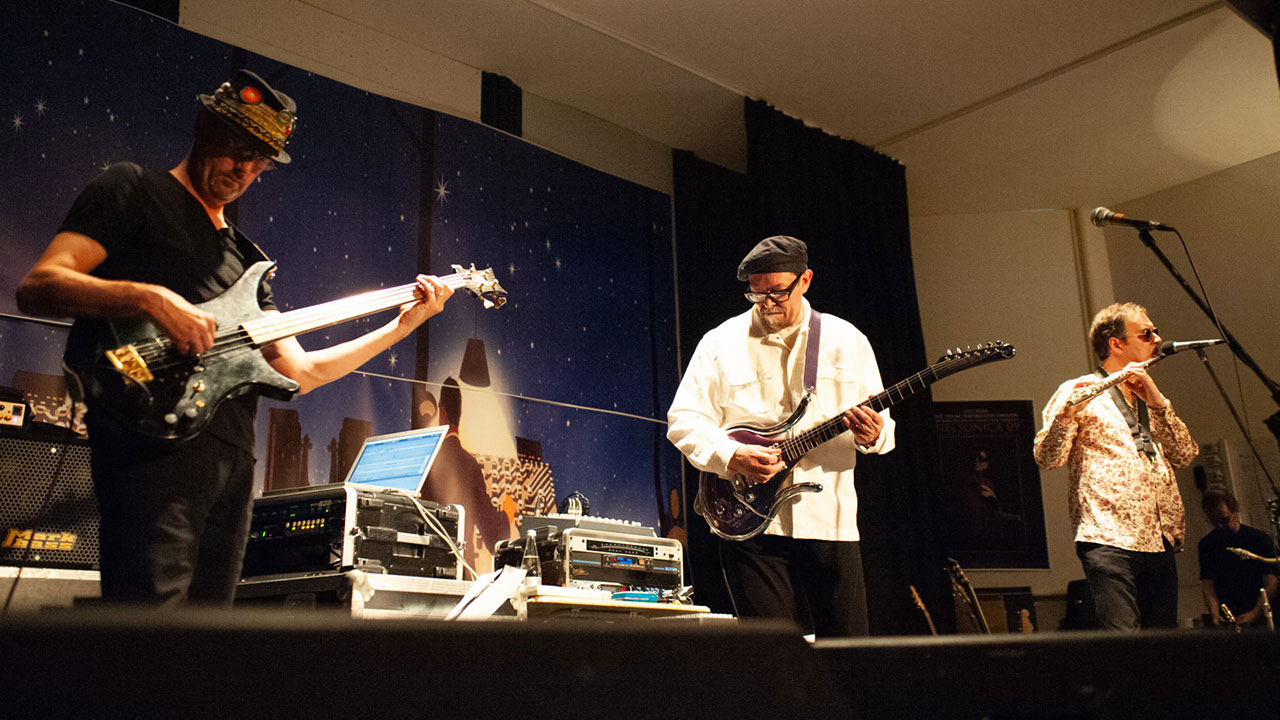“They are always adventurous and challenging. And like Yes and Genesis, they still have great songs at the heart of it.” It's Radiohead's proggiest moments
From grungy indie to avant-garde rock, Radiohead have always been restlessly creative. Here's their proggiest tracks

A band that has always been extremely polarising within the prog community, Radiohead’s name is often met with either glowing adoration or groans. Yet, their sense of adventure has never been up for debate. From Pablo Honey’s grunge-dipped alt-rock and the stratospheric success of OK Computer’s stirring melancholia to King Of Limb's electronic-jazz exploits and collaborating with Hans Zimmer, they’ve never been afraid to try new things.
Radiohead have always been a band to challenge the norms too, which has captured Geddy Lee’s heart in the process. Speaking to The Quietus in 2012, he ranked OK Computer among his favourite records, and saw them as a shining light for progressing progressive music.
“To me, Radiohead carried on the tradition of bands like Yes,” he said. “They are always adventurous and challenging and yet they have remained ahead of the game, really. And like Yes and Genesis, they still have great songs at the heart of it.”
Throughout their career, as this list attests, their progressive ambitions have been a perpetual undercurrent to their songwriting, from subtle flourishes to grandiose complexity. Here, we run through the band’s ten proggiest moments...

Weird Fishes/Arpeggi
From 2007’s In Rainbows, which was released as a pay-what-you-want download helping set a trend continued by countless artists today, Weird Fishes/Arpeggi is a fine example of the band’s hidden complexities. Without getting bogged down by technical mumbo-jumbo, not only is its jittery intro instantly recognisable, it also has three time signatures happening at once. Drummer Philip Selway and both guitarists – Jonny Greenwood and Ed O’Brien – purposefully play out of sync with each other to create a beautiful, moving piece of art rock belying of its disjointedness.
Exit Music (For A Film)
Since its release, Exit Music (For A Film), while not written for the silver screen, has been used countless times in film and TV thanks to its gripping cinematic darkness. It hangs heavy, providing the musical bedrock for shadowy plot twists and tear-jerking moments with, Romeo + Juliet, Black Mirror and Westworld all using the song to heighten the drama of their storytelling to name just a few. The latter was a re-imagined string quartet working, proving it isn’t just its lyrics, but the atmosphere of the song as a whole that has made the song such a success.
Spectre
Written for the 2015 James Bond film of the same name, Spectre’s progressive approach to Bond themes was supposedly rejected for being too depressing, with Sam Smith’s more hopeful Writing’s On The Wall chosen instead. Featuring night-dark piano, mournful strings and a powerful, wounded vocal performance from Thom Yorke, they twisted many iconic Bond theme tropes through their own lens, maintaining the class and grandeur of the Franchise but adding the grit and more vulnerable nature of Daniel Craig’s reinvented secret agent. It shows that the band will always do things their way.
Sign up below to get the latest from Prog, plus exclusive special offers, direct to your inbox!
Bloom
As Radiohead developed as musicians and songwriters, they began to prioritise rhythms over melodies. Bloom is another song to open an album in a strange way, but as its shuffling, dislocated rhythm unravels, it takes on a hypnotic effect. Thom Yorke is quoted as saying that “almost every tune is like a collage” and that on Bloom, “the melodies were there but so much was implied so that when you did embellish, it [would] really come out of itself.”
The National Anthem
Another pick from Kid A, whilst The National Anthem starts with a typically Radiohead alt-rock bassline, where it progresses to gives the song so much more. The album writing sessions were heavily jam orientated, with Can cited as a driving factor for that, but it’s the spirit of Beefheart that’s most prominent in the discordant brass that wrangles and writhes above that driving bassline.
15 Step
Yorke says the song, from In Rainbows was “born out of a mad rhythm experiment.” Underpinned by a stuttering electronic drum beat in 5/4, the band adopts a twofold approach on top of its pulse, with uneasy, unhappy and jarring moments greatly contrasting the brighter refrains that add a greater melodic power to the songs captivating weirdness.
Pyramid Song
On its surface, Pyramid Song is just a sad piano ballad bruised with sweeping strings. Dig deeper though and you’ll find irregular rhythms pulling the song in different directions as it draws heavily from the avant-garde jazz of the late Charles Mingus. For its lyrics, meanwhile, Yorke found inspiration from an Egyptian underworld exhibition he had visited whilst recording in Copenhagen, as well as Buddhist musings on time. The track remains a mainstay of their live shows today.
My Iron Lung
Even at their most primal, Radiohead loved making music that flirted with the bizarre. My Iron Lung doubles the clean guitars of its verse with surreal effects-lavished takes that give the progression an evil undertone before lurching into a chaotic, punching chorus. Elements of the song wouldn’t sound out of place on King Crimson’s THRAK, released that same year and its template would later become the blueprint for large chunks of Muse’s debut album Showbiz.
Identikit
From their most recent album, 2016’s A Moon Shaped Pool which showcased a much more stripped back sound, Identikit prevails as a major highlight. Its perpetual motion is attained by Selway’s sharp, stabbing beat, as choral textures, ethereal electronics and jutting overdriven guitars come and go. The dizzying repetition of Yorke’s vocal refrain grows increasingly agitated and besmirched before grating jazz guitars see out the song in a way that only Radiohead could by finding something beautiful in jarring noise.
2+2=5
Contrary to what its title says, Hail To The Thief’s opener actually starts out life in 7/8, an in-the-pocket drum groove counterbalanced with palm muted, arpeggiated chords that uses the odd time measures to build tension to breaking point – Yorke’s haunted vocals and uncomfortable harmonies adding to the tracks unwieldiness.
Then it shifts into 4/4 just as Yorke croons the like “two and two makes five”, yet the song’s agitation isn’t relinquished. Instead it writhes in overdrive; the song always feeling like it’s about to fall apart but never doing so. It’s untamed but calculated nature is a paradox.
In Limbo
This often overlooked number from the highly experimental Kid A plays out like a fever dream, it’s jankily played guitars – in 6/4 – doing very little to lock in with the drums, creating a topsy-turvy feel that, this writer at least, feels knotting his stomach. It’s the kind of woozy but adroit song that would sit comfortably on almost any art rock record.
Originally, it had the working title Lost At Sea and both states – being stuck in the no man’s between spaces, and hopelessly at the mercy of the sea’s currents – is achieved by its tactfully clashing instrumentation. For anyone who’s only heard Creep and Karma Police, garish, leftfield tracks like this will be a huge shock to the system.
Jigsaw Falling Into Place
Another In Rainbows cut, the acoustic-led affair takes on a subtly progressive folk flavour but soon journeys beyond the pale. Lyrically, Jigsaw... finds Yorke ruminating on his experiences partying in Oxford but, as ever with Radiohead, there's something more sinister lying beneath the surface; there is no happy ending to the story.
The lyric “words are sawn-off shotguns” toys with the caustic nature of booze and how viscous truths come out to play after one too many, and instrumentally, that concept is mirrored. What starts out as a pleasant head-bopper grows more unkempt and animalistic as it goes on, the fact the drums and guitars never properly syncopate creates a off-kilter, drunken feeling while Yorke delivers scathing retort after scathing retort.
The Tourist
Slow, tender, and as ornate as fine china, OK Computer’s closing track is a drawn out and meditative affair that floats in a decidedly Floydian ether. Thom Yorke’s arcing vocals play off Ed O’Brien’s cascading guitar parts and slow waltz drums before bursting into a noisy but controlled art rock finale. The song feels free of convention, with the band simply letting the tide of the music take them down a gorgeous path that ices what is still today regarded as the band’s seminal LP in stirring, unmistakably Radiohead fashion.
Paranoid Android
Trying to find a post-rock fanatic that doesn’t hold this track in high regard is like finding a needle in a haystack. A track of two halves, it’s ethereal beginnings, complete with post-rock approved spoken word parts, morphs into a gritty neo-prog affair spearheaded by a snarling bassline that sounds like it would stab you in the back with pleasure, and an erratic guitar solo that evokes the spirit of the late, ever-oddball Captain Beefheart.
No section is copy and paste, and when motifs return, they do so re-imagined. Greenwood’s second solo is another feral affair, punctuating the track in style. It’s also the band’s second longest song, and one hell of an immersive, perpetually reshaping journey.
Honourable mentions can also go to A Moon Shaped Pool's warm, stripped-back Desert Island Disk, which plays out its dreamy soundscapes in 7/4, but doesn't quite have the same level of adventurism as the rest of the songs on the list, and Morning Bell’s two differing versions.
The original Kid A track blends the sharp edges of Philip Selway’s energetic 5/4 drums – a man who has previously credited King Crimson and Pink Floyd’s “ambition” as influences for Radiohead, with the tranquillity of Yorke’s electric piano and purring vocals. The reissue version, Morning Bell/Amnesia is a languid affair that sounds like Willy Wonka’s chocolate factory on a comedown. It’s a wonderfully surreal track and a far cry from the album proper version.
You can usually find this Prog scribe writing about the heavier side of the genre, chatting to bands for features and news pieces or introducing you to exciting new bands that deserve your attention. Elsewhere, Phil can be found on stage with progressive metallers Prognosis or behind a camera teaching filmmaking skills to young people.













